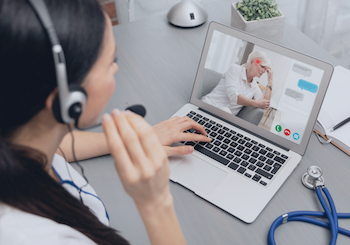Though telehealth has been around for decades, it took COVID-19 to help it achieve broad adoption. Video has now become an invaluable tool both for physicians and the patients they serve.
Care providers using videoconferencing have been able to provide early evaluation and advice to those suspected of having the virus while eliminating the possibility of exposure. And they have been able to keep patients with non-COVID health concerns away from physician’s offices, emergency departments and other care facilities where they are likely to encounter the virus.
Two changes made by public regulators have paved the way for the uptick. The first is a relaxation of HIPAA privacy regulations so healthcare providers can adopt commercially available video conferencing solutions used by the general public. The second is a decision to reimburse telehealth services at the same rate as regular, in-person visits.
What will happen once this crisis is behind us? We believe it is likely that video appointments are here to stay. As a matter of fact, we have been believers in telehealth for years and even helped to develop a system 6 years ago. The financial pressures COVID-19 has placed on the healthcare system – especially smaller, remote community hospitals – will make it imperative that they adopt new, more cost-effective ways of working. In addition, both patients and providers have now had the chance to experience the efficiency of telehealth and to appreciate the reduced risk of being exposed to contagious diseases.
For these reasons, we feel it is likely that the Department of Health and Human Services and the Centers for Medicare and Medicaid Services will continue to embrace and encourage video conferencing as an alternative form of care delivery.
Closing the Information Gap
There is one missing link, though, that will impact whether telehealth retains its current level of popularity. And it involves how to capture and share the HIPAA-protected information surrounding these patient encounters.
A longstanding telepsychiatry program provides a clear example of this gap and how it can be addressed. The North Carolina Statewide Telepsychiatry Program (NC-STeP) was launched to serve communities that lacked enough behavioral health providers to meet demand. With NC-STeP, hospital emergency departments can use video to connect patients with remote mental health professionals who are experienced in treating urgent psychiatric and substance abuse issues.
For the program to succeed over the long haul, though, program administrators knew they had to address “back office” issues. Hospitals and remote care providers needed a way to exchange clinical and administrative data, schedule consultations, share patient assessments, make referrals, collect the encounter data needed for billing, and determine the availability of inpatient mental health beds. And they needed to do it all securely.
In 2013, Proficient Health partnered with the North Carolina Hospital Association to design a HIPAA-compliant solution for NC-STeP that is easily transferable to other telehealth settings. A user-friendly, online portal eliminates the costly, paper-based processes that can slow service delivery, increase costs and make it difficult to coordinate care.
With the portal, all communication happens online – from initial scheduling to end-of-consult billing. It becomes easy for providers to associate information with the appropriate patient record and to download data directly into their electronic health platform of choice.
Health systems, accountable care organizations, clinical information networks and other organizations that want to realize the efficiencies of telehealth will need to address this same information gap. Fortunately, it’s easy and affordable to do.

